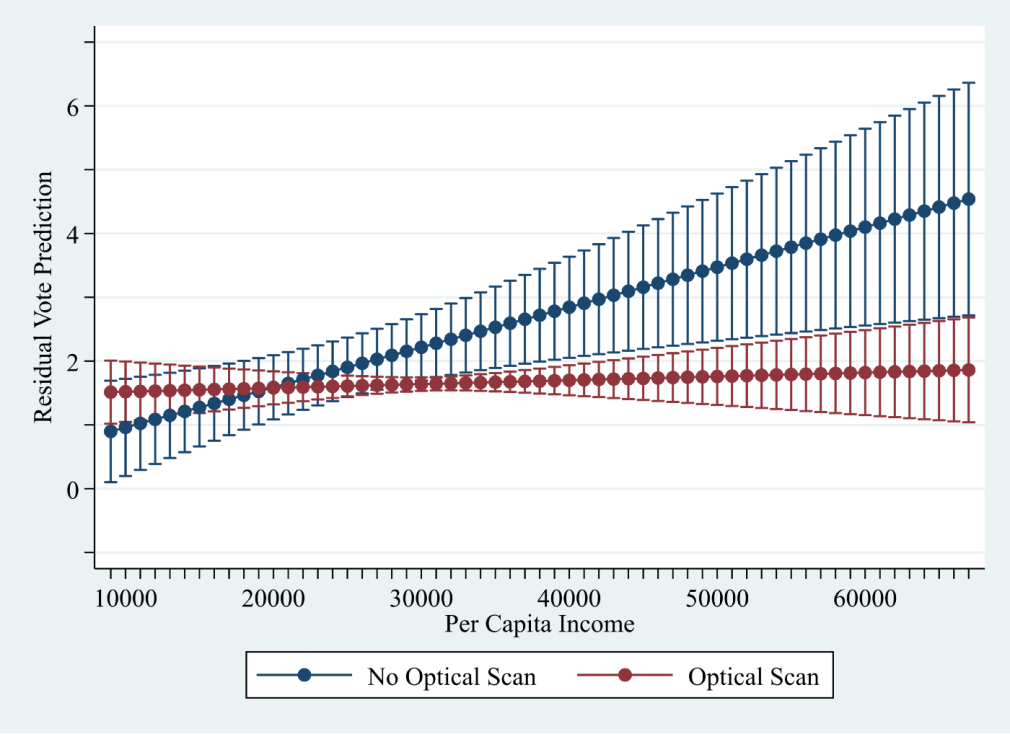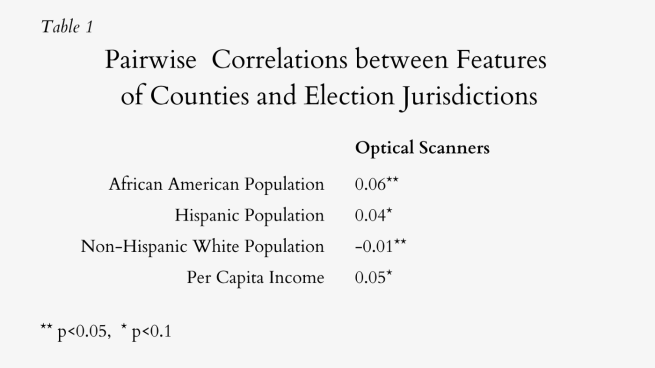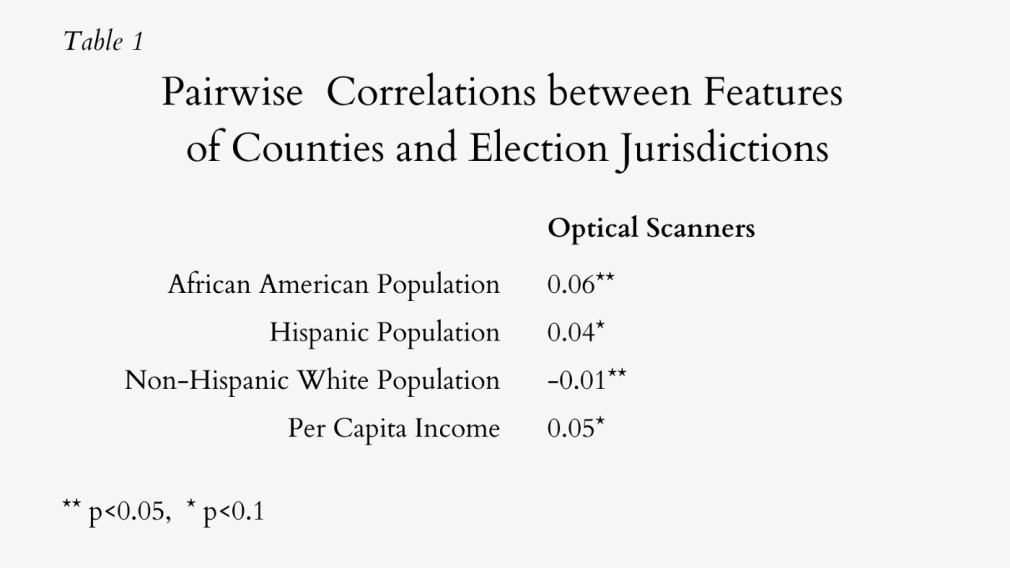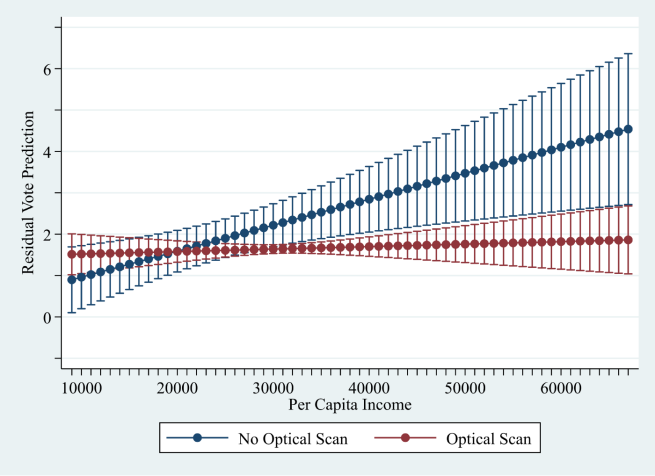Exploring Voting Equipment and Inequality in the 2016 U.S. General Election (Part 2)
Using county-level residual voting rate and demographic data to see how voting equipment can shape voting equality
In this second part of the series, the next question to evaluate is whether inequalities in access to quality voting equipment are more prevalent in election jurisdictions that are poorer or have higher densities of racial minorities. In the first part of the series, it was demonstrated that optical scan machines are negatively correlated with residual voting rates. A key question evaluated here is whether counties that are poor or have more racial minorities are less likely to have such machines, and whether contributes to higher residual voting rates in these areas.
Are Election Laws Biased?
The U.S. has a long history of biases in election laws and procedures treating non-Hispanic whites and middle to higher socio-economic class citizens more favorably than racial minorities and the poor (Keyssar 2009; Ritter and Tolbert 2020; Springer 2014). With the exception of HAVA, passed in 2002 in the wake of the 2000 Florida election debacle, funding for state and local election machines must come from either state or local taxes (Lichtenheld 2020; Stewart 2011). This means that more affluent areas are more likely to be able to afford higher-quality election machines that are less likely to lead to high residual vote rates.
In the United States, income inequalities track race-based inequalities closely because of the long history of various structural inequalities in U.S. history (Schlozman, Verba, and Brady 2012). This means also that non-Hispanic whites tend to earn more income than racial minorities such as African Americans and Hispanics. Since there is a large degree of de facto residential segregation in the United States even today (Rothstein 2018), this makes it likely that not only will poorer areas have less money to invest in quality voting machines, but also that racial minority areas will have less money to invest in such machines.
Uncounted Votes in Low-Income, High-Minority Districts
Following the 2000 election, research found that high residual vote rates in Florida were uniquely likely to be features of racial minority and lower income areas. In these areas, faulty election equipment such as punch card voting machines were more likely to present obstacles to voters (Caltech/MIT 2001; U.S. Civil Rights Report 2001). Research indicates that between 4 to 6 million votes nationwide, and 1.5 to 2 million in Florida, were unrecorded or uncounted. The House of Representatives Committee on Government Reform (2001) sponsored research that analyzed voting results from 40 congressional districts in 20 states; 20 of these districts had high poverty rates and small minority populations, while 20 had low poverty rates and small minority populations. The research found that voters in low-income, high-minority districts were significantly more likely not to have their votes counted, and that low-quality election machines (e.g., punch cards and level machines) were a significant factor behind the outcome. The research also found that better election machine technology available in low income and high-racial minority density areas minimized the disparity in uncounted voters. One of the resulting recommendations from this research was that election jurisdictions replace punch card and level election machines with optical scan ballot and DRE election machines (MIT/Caltech 2001; U.S. Civil Rights Report 2001). Many election jurisdictions have abided by these recommendations and have replaced punch cards with optical scanners or DREs (Stewart 2014, 231–232).
Stewart (2014) examines various legal and demographic factors behind election machine usage across the American states. Before HAVA was passed in 2002, voting machines varied more across localities and states, and were selected for either functional reasons, such as local or state laws that required certain types of election machines, or demographic factors, such as larger and more prosperous jurisdictions being able to afford automated voting systems. Since HAVA and more federal involvement and financial disbursement to states for the improvement of election administration, including the utilization of higher-quality election machines, “differences across localities using difference machines has flattened out” (Stewart 2014, 233). Before HAVA, automated voting systems such as DREs were more common in counties that were on average of higher income and more racially diverse. After HAVA, “the racial compositions and median incomes of counties using DREs and optical scanners are now virtually equal” (Stewart 2014, 233–234). Consistently, various studies have shown that counties with new election equipment (DREs and optical scan machines) are more likely to have narrower residual vote differences between racial minorities and non-Hispanic whites (Knack and Kropf 2003; Stewart 2004; Stewart 2006; Tomz and van Hauweling 2003).
Do Election Machine Inequalities Persist?
This part of the study contributes to voting and inequality literature by assessing whether inequalities in access to quality election machines persist, and whether these disparities continue to result in higher residual voting rates for racial minorities (African Americans and Hispanics) relative to non-Hispanic whites, and higher residual voting rates for lower relative to higher income Americans. While studies have examined the racial dimensions of residual voting, they have not given extensive attention to how election machines impact racial minorities relative to non-Hispanic whites. Additionally, little attention has been allocated to how low versus high income individuals are impacted by election machines. The expectations are that counties with higher percentages of non-Hispanic whites (relative to racial minorities) and high income individuals (relative to low income individuals) will be more likely to have access to higher-quality election machines, and also will have lower residual voting rates linked to election machine usage. Higher income areas, which are also more likely to more highly populated by non-Hispanic whites, are more likely to be able to afford higher quality election machines and more timely updates.
Evaluating the Impact of Election Machines on Inequality
To evaluate these questions, the same dataset and methodology from the first part of this series is employed. Before moving to a summary of the regression analyses, Table 1 presents pairwise correlations to see how access to optical scan machines — the type of election equipment consistently linked to lower residual voting rates in 2016 — varies by the demographic features of a county. If the expectations are correct, the correlations should show that areas with more racial minorities and that are poor are less likely to have such machines. The results are mixed. Areas with more African Americans and Hispanics are more likely, and more non-Hispanic Whites less likely, to have access to optical scanners. This finding, though, is consistent with Stewart’s (2014) finding that in the aftermath of HAVA, optical scanners are equal distributed across counties as measured by racial composition; in fact, the results in Table 1 (below) suggest that more densely racial minorities are more likely to have this equipment.
Conversely, there is a positive correlation between a county’s per capita income and residual voting. In recent years, many counties have been moving from DREs to optical scanners because of concerns linked to voter verification, variations in computer experience among prospective voters, and security (Herrnson et al. 2008; National Academies of Sciences, Engineering, and Medicine 2018). This finding makes sense insofar that higher income areas have more financial resources to devote to voting machine changes and maintenance, which also doubles as evidence that these areas have led recent American election jurisdiction movements away from DREs to optical scan machines (Stewart 2014).
Next, the regression analyses test if access to election equipment has unique impacts on the residual voting rates of counties, varying these demographic features. Several possibly confounding variables, including average county age, percent of county population with a four-year college or more, and others, are also included in these analyses. To evaluate if optical scan machines are related to higher of lower residual voting rates varying these county demographic features, interaction variables between this election machine variable and the racial group population and per capita income measures are employed.
The results show negative and significant interactive relationships between optical scan machines and higher percentages of African Americans or Hispanics in counties. This means that such counties are predicted to have significantly lower residual voting rates when these voting machines are present. Converting these results to substantive results, residual voting rates decreased by 1.4% in the counties with the highest relative to the lowest African American populations and decreased by 0.46% in counties with the highest relative to the lowest Hispanic populations. This evidence suggests that optical scan machines are particularly effective at reducing residual voting rates in counties with higher racial minority populations.
Conversely, there is a negative and significant interactive relationship between per capita income and optical scan machines. This indicates that residual voting rates linked to this election machine are lower in counties of higher income. To aid in the interpretation of the interactive effect, Figure 2 shows how the relationship between income and optical scan machine varies between the minimum ($9,000) and maximum ($67,000) county per capita income values. At the lowest values of per capita income, residual rates associated with the non-presence or presence of optical scan machines are approximately the same at about 0.5%. However, at higher levels of per capita, counties with no optical scan machines are linked to higher residual voting rates — by nearly 2.5% — than counties with optical scan machines. These results clearly show that optical scan machines have a more favorable relationship to residual voting rates in counties with higher per capita incomes.

Figure 2: Effect of Optical Scan Voting Machines on Residual Voting Rate, varying Per Capita Income at County-Level
In review, the results provide a mixed assessment of the hypotheses evaluated in this study. There is evidence that more highly racial minority populated counties are not disadvantaged relative to more non-Hispanic white counties in their access to optical scan machines, and further results show that these machines actually have more favorable linkages to residual voting rates in counties with higher percentages of racial minorities rather than non-Hispanic whites. Conversely, evidence indicates that election machines such as optical scan machines are more likely to be available in higher income areas, and these machines are related to lower residual voting rates in these same areas. While the racial group-election machine relationships show that counties with higher percentages of racial minorities derive more benefits from these machines, the per capita income-optical scan machine finding suggest that poorer relative to wealthier counties get less of a benefit.
References
Caltech/MIT Voting Technology Project. 2001. “Residual Votes Attributable to Technology: An Assessment of the Reliability of Existing Voting Equipment.” VTP Working Paper #2.
Herrnson, Paul S., Richard G. Niemi, Michael J. Hanmer, Benjamin B, Bederson, Frederick G. Conrad, and Michael W. Traugott. 2008. Voting Technology: The Not-So-Simple Act of Casting a Ballot. Brooking Institution Press.
Keyssar, Alexander. 2009. The Right to Vote: The Contested History of Democracy in the United States. Basic Books.
Knack, Stephen, and Martha Kropf. 2003. “Invalidated Ballots in the 1996 Presidential Election: A County-Level Analysis.” Journal of Politics 65(3): 881–97.
Lichtenheld, Peter. 2020. “The Role of Election Vendors in Election Administration.” In The Future of Election Administration, eds. Mitchell Brown, Kathleen Hale, and Bridgett A. King. Palgrave Macmillan.
National Academies of Sciences, Engineering, and Medicine. 2018. Securing the Vote: Protecting American Democracy. Washington, DC: The National Academies Press. http://doi.org/10.17226/25120 (accessed June 30, 2020).
Ritter, Michael, and Caroline Tolbert. Accessible Elections: How the States Can Help Americans Vote. Oxford University Press. Forthcoming 2020.
Rothstein, Richard. 2018. The Color of Law: A Forgotten History of How Our Government Segregated America. Liveright.
Schlozman, Kay Lehman, Sidney Verba, and Henry E. Brady. 2012. The Unheavenly Chorus: Unequal Voice and the Broken Promise of American Democracy. Princeton University Press.
Stewart, Charles, III. 2014. “The Performance of Election Machines and the Decline of Residual Votes in the United States.” In The Measure of American Elections, eds. Barry C. Burden and Charles Stewart III. Cambridge University Press.
Stewart, Charles, III. 2011. “Voting Technologies.” Annual Review of Political Science. 13: 353–378.
Stewart, Charles, III. 2006. “Residual Vote in the 2004 Election.” Election Law Journal 5(2): 158–169.
Stewart, Charles, III. 2004. “The Reliability of Electronic Voting Machines in Georgia.” Caltech/MIT Voting Project Working Paper 20.
Tomz, Michael, and Robert P. van Hauweling. 2003. “How Does Voting Equipment Affect the Racial Gap in Voided Ballots?” American Journal of Political Science 47(1): 46–60.
United States Commission on Civil Rights. 2001. “Election Reform: An Analysis of Proposals and the Commission’s Recommendations for Improving America’s Election System.” http://www.usccr.gov/pubs/vote2000/elecref/main.htm (accessed June 30, 2020).
United States Congress. House. Committee on Government Reform. 2001. Income and Racial Disparities in the Undercount in the 2000 Presidential Election, July 9, 2001. https://www.usccr.gov/pubs/vote2000/elecref/ch3.htm#_ftnref15 (accessed June 30, 2020).



